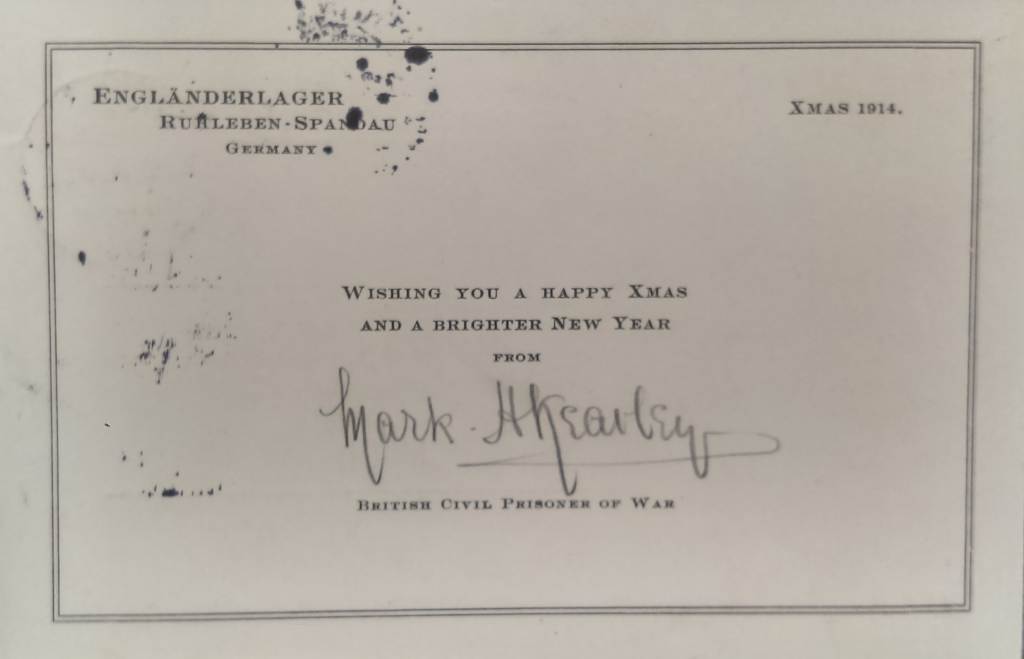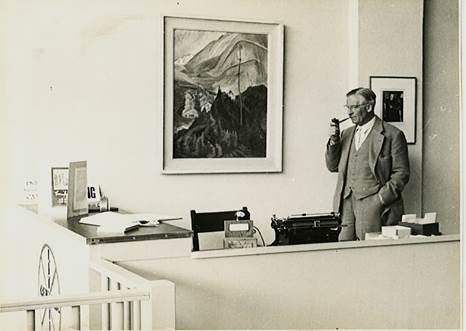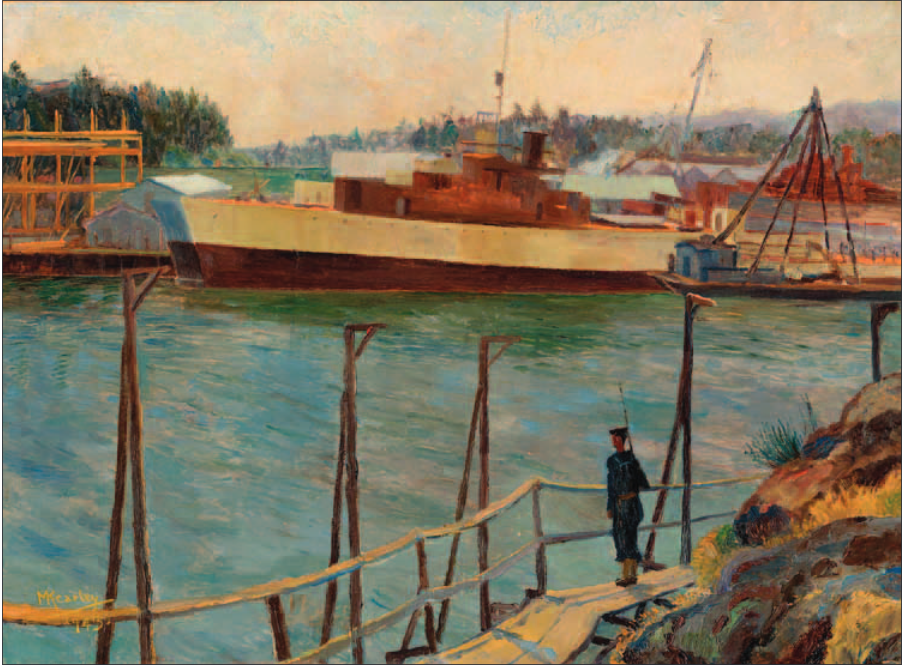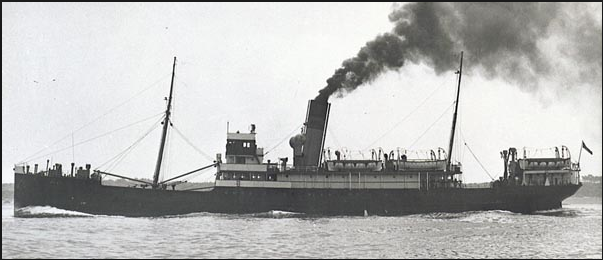Hon. Mark Hudson Kearley (1895-1974)
Kearley was born on 3 March 1895; he was the second son of Hudson Ewbanke Kearley, 1st Viscount Devonport (1856–1934), a Liberal politician and the founder of the International Stores, and Selina Chester (1851–1931). Viscount Devonport was Parliamentary Secretary to the Board of Trade when David Lloyd George (1863–1945) was its President. He served as Minister of Food Control during the war. When he received his barony in 1910 he was accused of having “bought it”, an accusation which he denied, although Hilaire Belloc (1870–1953) did not accept his denial:
The grocer Hudson Kearley, he
When purchasing his barony
Considered first, we understand,
The title of Lord Sugarsand,
Or then again he might have been
Lord Underweight of Margarine:
But being of the nobler sort
He took the title Devonport.
Kearley was educated at Eton and as a Commoner at Magdalen (1913–14). He did not return to Magdalen after his release from internment.
At the outbreak of war he was travelling in Germany with William George Shiell and they were both interned at Ruhleben, Kearley from 1914 to 1918. After the war he became active in the Ruhleben association.[1] His father, not surprisingly, took a great interest in Ruhleben and spoke on several occasions in the House of Lords, on the most significant occasion on the condition of the prisoners at Ruhleben in 1916, as reported in Hansard.[2]

Christmas card to President Warren, 1914[3]
Kearley sent President Warren a card from Ruhleben for Christmas 1914 and a letter[4] to the President dated 10 July 1916 after he had been in the camp for nearly two years, and after his travelling companion, Shiell, had been repatriated. In the letter Kearley writes something of his life in the camp, although with the caveat that there is more to tell “which for the present at least must remain ‘taboo’ in my letters from here”. First he discusses how he spends his time “reading books I had heard of but which I have hitherto never had an opportunity of getting to know from first hand knowledge. Then of course, there are the various foreign languages.” But what he feels to be most important is getting to know people from all walks of life, the criminals, gamblers and prize-fighters as well as the painters, musicians and professors, as commented on by Professor Alonzo Taylor (see the introductory essay here on ‘Internees’). Kearley writes “Here we come into touch with types of men, whom we probably never would have met in our ordinary round of life. […] Every day as I walk about the camp talking to different kinds of men I learn new lessons about life or get a deeper insight into human nature.” But his old life was not completely forgotten, for in the same letter he writes “On June 4th, the Old Etonians had their yearly celebration and after dinner, such as camp life provides, sent a Latin greeting to the Headmaster.” [“Prid Non Jun. A.D. MDCCCCXVI. Floreat Etona, Floreat Florebit. Almam matrem salutamus Etonenses internati.”] He then lists some of the Oxford Old Etonians in the camp.
Kearley was in Barrack VII, which was known as the “millionaires’ barrack” because of the number of wealthy men interned there.[5] The barrack captain was initially Captain Edward Russell (1864–1917), the captain of the SS Bury, a passenger and cargo ship of the Great Central Railway, which was interned in Hamburg at the beginning of the war. Captain Russell died in Ruhleben on 28 December 1917.
Early on Russell was followed as Captain of Barrack VII by Cyril A. Hallam, who in September 1915 was followed by Philip Frederic William Simon (1869–1943) who was a Manufacturing Electrical Engineer.
Kearley married Mabel Florence Dagley (1900–67) in Munich on 26 May 1928. They had three children. Only one seems to have been born in England or Wales. Their address at the time of their marriage was Chalet du Vallon Château-d’Oex, Switzerland, and the connection with Château-d’Oex continued. He gave it as one of his two addresses, the other being Metchosin, British Columbia, in his entry in the 1966 edition of the Magdalen College Record, and his youngest son organized a Balloon Festival there in 2003. The family had emigrated to Canada sometime during the 1930s, and in 1956 the youngest son, skiing for Cambridge University against Oxford, was described as a Canadian. Kearley died at Château-d’Oex on 18 March 1977.
Kearley became an artist–designer and exhibited at the Royal Academy in London, and in Munich, Switzerland and Canada. He was most probably influenced by the many artists interned with him at Ruhleben, who set up a studio, gave lessons and held exhibitions. He settled in British Columbia and in 1941 had a timber house built by a shipwright in Metchosin on Vancouver Island. He was very keen on promoting art, and Canadian art in particular. Together with the great Canadian artist Emily Carr (1871–1945), he was a founding member of the Victoria branch of the Federation of Canadian Artists; and in 1946 he published a booklet about her, A Few Hints and Suggestions about Emily Carr and her Work (Federation of Canadian Artists). While Emily Carr and British artist Katherine Maltwood (1878–1961), who had moved to Victoria disillusioned with the state of Europe, unsuccessfully proposed the idea of an art gallery in Victoria, it eventually came into being as the Art Gallery of Greater Victoria in 1944 with Kearley as one of its co-founders. Today the Art Gallery of Greater Victoria includes a Kearley Gallery.

Mark Kearley in 1946 in the Little Centre – the precursor to the Art Gallery of Greater Victoria; the painting is by Emily Carr [6]
In 1943 Kearley was chosen by the Canadian War Artists Committee to chronicle naval activities at Naden, which was at that time the home port of the Royal Canadian Navy on the Pacific Front.

On Guard, by Mark Kearley, HMCS Naden 1943[7]
After the end of the war Kearley continued to be interested in Germany. In 1930 he was one of the contributors to Brito-Germania. Ein Weg zu Pan-Europa? Warum wieder Weltkrieg? Ausblick in die künftige Entwicklung Europas (Brito-Germania. A Path to a Unified Europe? Why Have another War? Outlook for the Future Development of Europe) edited by Wilhelm Adam Samuel Lothar Max Friedrich, Freiherr von Richthofen (1888–1962). In 1941 Kearley published a pamphlet, The Germany That I Have Known: A Talk by The Hon. Mark Kearley Delivered before the United Services Institution of Vancouver Island, Victoria, B.C., February 8th, 1941.
The first of these suggests that he wanted to promote a close relationship between Britain and Germany. One of his co-contributors was Henry Rolf Gardiner (1902–71), who wrote several letters to The Times in the early 1930s supporting the German Nationalism[8] movement and the union of Germany and Austria.[9] Although undoubtedly holding right wing views, his main interests were in folk dancing; what would now be called organic farming and land management; and youth movements.[10] The other co-contributor was Sigmund von Kapff (1864–1946), a chemist and director of the textile school in Aachen, who was later head of the Reich Association of Drug and Therapeutic Products. Little is known of the editor.
While all three Magdalen men detained at Ruhleben no doubt suffered during their internment, the suffering of the men in the “millionaires’ barrack” was to some extent mitigated by parcels from home and being able to buy food from shops in Berlin. For those in the camp who were destitute and came from poor homes, the imprisoned seamen for example, there were no such luxuries, and until they were helped out by the government they had to rely on charity and on paid work for the men of “millionaires’ barrack”.
—
[1] The Times, no. 45,975 (9 November 1931), p. 17.
[2] British Prisoners at Ruhleben, Hansard, HL Deb. vol. 22, cols 578–96 (5 July 1916).
[3] Magdalen College Archives: PR32/C/3/735i.
[4] Magdalen College Archives: PR32/C/3/732i–iii.
[5] Joseph Powell [Captain of the Camp] and Francis Gribble, The History of Ruhleben: A Record of British Organisation in a Prison Camp in Germany (London: Collins Sons & Company Ltd, 1919), p. 8.
[6] This photograph is reproduced with thanks to the Art Gallery of Greater Victoria.
[7] Reproduced with thanks to Tatiana Robinson from her article ‘Artist captured Wartime Life in Naden’ from Headway (CFB Esquimalt Naval and Military Museum newsletter), vol. 13 (Winter 2016), p. 8.
[8] Letter to The Times, no. 46,407 (31 March 1933), p. 10.
[9] Letter to The Times, no. 46,837 (20 August 1934), p. 15.
[10] See ‘Rolf Gardiner’, Wikipedia: https://en.wikipedia.org/wiki/Rolf_Gardiner (accessed 26 April 2022).
